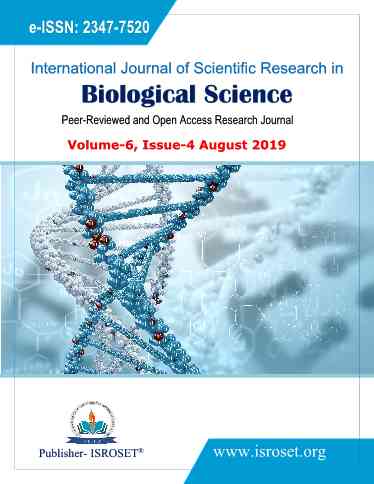Preliminary Phytochemical Analysis And Antimicrobial Activty Of Andrographis Serphyllifolia- (Rottler ex Vahl) Wight: Acanthaceae
Keywords:
Andrographis serpyllifolia, phytochemical screeningAbstract
Andrographis serpyllifolia (Rottler ex Vahl) Wight, belonging to Acanthaceae family known for its ethnobotanical importance and possess anti- venom potential especially for snake and scorpion bites. The present study is focused to evaluate the phytochemical profiles and antimicrobial activity A. serpyllifolia using petroleum ether, acetone and methanol solvents. The results revealed that presence of alkaloids, flavonoids, saponins, phenols, steroids, glycosides, tannins and resins in various extracts studied. Antibacterial activity of A. serpyllifolia against Gram negative bacterial strains Serratia marcescens and Escherichia coli showed 6 mm and 9 mm zone of inhibition respectively in 50% concentration of extracts studied. Antifungal activity of petroleum ether extract showed highest zone of inhibition (11 mm) against Penicillium notatum and Fusarium oxysporum at 100% concentration.
References
WHO. Legal Status of Traditional Medicine and Complementary/Alternative medicine: A world wide review. WHO Publishing, 2001.
J. Hussain, A.L. Khan, N. Rehman, M. Hamayun, Z.K. Shinwari, W. Ullah, I.J. Lee, “Assessment of herbal products and their composite medicinal plants through proximate and micronutrients analyses”, Journal of Medicinal Plants Research, Vol.3,Issue.12, pp. 1072-1077, 2009.
Fazal, N. Ahmad, B.H. Abbasi, N. Abbass, “Selected medicinal plants used in herbal industries; their toxicity against pathogenic microoraganisms”, Pak. J. Bot., Vol.44, Issue. 3, pp. 1103-1109, 2012.
S.K. Jain, “Glimpses of Indian Ethno botany. Oxford & IBH Publishing Co., New Delhi, India, 1981.
S. Krishnaswamy, B.A. Kushalappa, “Systematic Review of Andrographis serpyllifolia (Rottler ex Vahl) Wight: An Ethno-pharmaco-botanical Perspective. Pharmacog J. Vol.10, Issue.6, Suppl., pp.S14-S26, 2018.
P. Samydurai, A. Rajendran, A. Sarvalingam, C. Rajasekar, “Ethnobotanical knowledge of threatened plant species of Andrographis in Nilgiris Biosphere Reserve, Tamilnadu, India”, International Journal of Herbal medicine, Vol.5, Issue.6, pp.103-107, 2017.
M.G. Panduranga, K.B. Chandrasekhar, B.C. Leelaja, S. Lokesh, “Antimicrobial and Antioxidant Activities of Tribal Medicine formulation (TMF) accomplished for Wound related remedies in Biligirirangana Hill area of Chamarajanagara district, Karnataka (India), IJPC., Vol.5, Issue.8, pp.260-276, 2015.
C. Alageshaboopathi, “Ethnobotanical Studies on useful Plants of Kanjamalai Hills of Salem district of Tamil Nadu, Southern India”, Archives of Applied Science Research, Vol. 3, Issue.5, pp.532-539, 2011.
J.B. Harborne, “Phytochemical Methods, Chapman and Hall, Ltd”., London, pp. 49-188.1973
A.W. Bauer, W.M.M. Kirby, J.C. Sherris, M. Turck, “Antibiotic susceptibility testing
by a standardized single disk method”, Amer. I. C/in. Pathol., Vol.45, pp.493-6,1966.
[Depts. Microbiology and Medicine, Univ. Washington, Sch. Med., Seattle. WAI]
K. Narasimhamurthy, “Phytochemical screening and In vitro assessment of antimicrobial and antioxidant potential of Andrographis serpyllifolia - An endemic medicinal plant from South India”, International Journal of Advanced Research, Vol.2, Issue.2, pp. 917-928, 2014.
R.J.B.A. Ravishankar, V.S. Pradeepa, “Evaluation of the antimicrobial activity of three medicinal plants of South India”, Malaysian Journal of Microbiology, Vol.7, Issue. 1,pp.14-21.2011
Y. Xu, R.L. Marshall, T.K.S. Mukkur, “An investigation on the antimicrobial activity of Andrographis paniculata extracts and Andrographolide in vitro”, Asian. J. Plant. Sci., Vol.5, pp.527–530. 2006
C. Alagesaboopathi, “Screening of antibacterial potential of leaves and stem extracts of Andrographis serpyllifolia (Vahl) Wight – An endemic medicinal plant of India”, Journal of Pharmacy Research, Vol.5, Issue 12, pp. 5404-5407, 2012.
Downloads
Published
How to Cite
Issue
Section
License

This work is licensed under a Creative Commons Attribution 4.0 International License.
Authors contributing to this journal agree to publish their articles under the Creative Commons Attribution 4.0 International License, allowing third parties to share their work (copy, distribute, transmit) and to adapt it, under the condition that the authors are given credit and that in the event of reuse or distribution, the terms of this license are made clear.







